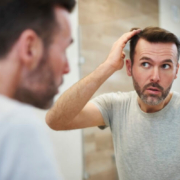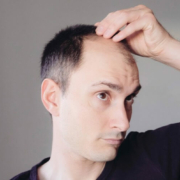5 Facts All Men Should Know About Hair Loss

A few weeks ago, my husband pointed out a Facebook meme that made us laugh. It showed two photos of hair and body care products. One photo included products that women use in the shower, and another photo showed the products that men use. The women’s photo was loaded with products, including body wash, face wash, two different types of shampoos, and a couple of different types of conditioner. The men’s photo only had one product, a lone all-in-one bottle of body wash, shampoo, conditioner, shaving cream, and toothpaste. Not only was it funny, but it also depicted the scene in our shower pretty accurately. The truth is, though, although some men don’t give their hair a lot of thought, I don’t know of any who are thrilled about the idea of going bald. It’s a super sensitive topic. As nonchalant as my husband is about his hair, even a hint that his hairline is receding results in a very alarmed “What?” and a close scalp examination in the mirror that night. Hair loss in men is common, but that doesn’t mean you’re okay with it. Nor does that mean that you have to accept your fate. So, if you’re a guy with some recession, thinning, or balding, this one’s for you. We’re here to fill you in on what you need to know about male pattern hair loss and what you can do about it.
1. Hair Loss in Men is More Common Than You Realize
According to the American Hair Loss Association, by age 50, 85 percent of all men will have significantly thinning hair. (01) Yes, you read that correctly. The majority of men will deal with some type of hair loss in their lifetime. Men lose their hair for a lot of different reasons. Balding or thinning hair can be due to autoimmune conditions, Covid, or even stress. The most common reason, though, is genetics. The vast majority of men with thinning or balding hair have androgenetic alopecia, male pattern baldness. Yup, that’s right. Your parents or grandparents may have passed along a baldness gene.
Male pattern baldness, also known as androgenetic alopecia, occurs when your testosterone is converted to an androgen (a sex hormone) known as Dihydrotestoterone (DHT). The DHT attacks your hair follicles and causes a reaction called miniaturization which shrinks the follicles. When that happens, the hair that is already there falls out. New hair has trouble emerging through the shrunken follicles, and eventually, the hair stops growing.
Although Male pattern baldness is the leading cause of hair loss among men; it’s not the only reason men lose their hair. Other forms of alopecia can cause hair loss among men as well. For example, Covid or other illnesses can cause a temporary hair loss called telogen effluvium. In this case, your hair will grow back within six to twelve months. Alopecia areata is an autoimmune condition that causes sporadic bald patches. Some men’s hair spontaneously regrows, but flares can occur at any time without notice. Lichen planopilaris is another type of alopecia that causes inflammation, leading to scars over the hair follicles that prevent new hair growth.
2. Timing is Everything When It Comes to Hair Loss Treatments
Many men avoid doctors like the plague. (02) However taking a “let’s wait and see what happens” attitude isn’t recommended when it comes to hair loss. If you don’t get treatment when you first notice that your hair is thinning, then your hair loss will most likely progress, leaving you with a higher number on the Hamilton-Norwood Scale. In case you don’t know what that is, the Hamilton-Norwood Scale is a classification system developed to measure the extent of baldness. You don’t want to get high scores on that test.
If you visit a board-certified dermatologist as soon as you see signs of thinning or balding, your doctor will identify the cause of your hair loss. Once you are diagnosed, your dermatologist can recommend treatments to stop your male pattern hair loss and to promote new growth.
3. Hair Loss Consultations Are Not a Big Deal (Really!)
If the idea of any medical procedure secretly has you a bit nervous, don’t let that prevent you from seeing a dermatologist. The exam is much easier than you would expect, and trust me, your dermatologist will not think you are vain for seeking treatment. Dermatologists evaluate men for hair loss conditions all the time. So, while you may be out of your comfort zone, your dermatologist certainly isn’t.
Your dermatologist will ask questions about your health, medications, family history, and lifestyle during your exam. The more detailed information you provide, the better. Your dermatologist will examine your scalp to evaluate your hair loss pattern and possibly do a pull test. A pull test measures the severity of your hair loss. During the test, your dermatologist will gently tug on small sections of your hair to see if any strands fall out. If six or more do, you have active hair loss. Dermatologists usually diagnose androgenetic alopecia based on visual exam. A blood test or a small biopsy may be ordered if he or she suspects another type of alopecia. Don’t stress if you need a biopsy. You’ll be numb, the biopsy area is small, and it heals within a week.
4. Today’s Hair Loss Treatments are Effective and Natural Looking
After you get a diagnosis, you’ll have many treatment options. The good news is more data than ever is available on hair loss treatments. Research indicates that many are not only safe, they’re highly effective. Here are some examples of the most popular prescription hair loss treatments used:
Minoxidil
- FDA approved to treat hair loss
- Available in oral or topical formulas
- Brings oxygen to the hair follicles, enlarging them so existing hair does not fall out and new hair can emerge
Finasteride
- FDA approved to treat hair loss
- Available in oral and topical formulas
- Prevents testosterone from converting to DHT and attacking your hair follicles
- First-line treatment for androgenetic alopecia
Dutasteride
- Used off label to treat hair loss
- Only available as a pill like our SuperCapsule
- Prevents testosterone from converting to DHT and attacking your hair follicles
- Prescribed if patient does not respond to Finasteride
- Lower dosage prescribed for Dutasteride than Finasteride
Cortisone
- Available in pill and topical formulas
- Reduces irritation and inflammation
Retinoic Acid
- Available in topical formula
- Proven to improve absorption of topical Minoxidil and Finasteride
Compounded Topical Formulas
Research has shown that combinations of topical formulas are more effective than monotherapy. For example, topical Finasteride combined with topical Minoxidil works better than one of the medications alone. (03) Finasteride and Minodixil combined with Retinoic Acid is more effective because the retinol helps the scalp better absorb the other two medications. (04)
Alternative Hair Loss Treatments for Men
You may also be a candidate for treatments such as Protein Rich Plasma (PRP), laser light treatments, and hair transplant surgery. Let’s talk about what these are and how they work.
Protein Rich Plasma
PRP acts similarly to Minoxidil by bringing oxygen to the hair follicles to enlarge them. During a PRP procedure, your dermatologist draws your blood. The blood is then separated. The plasma is then injected into sites where your hair is thinning or balding.
Laser Light Treatment
You may have seen ads for laser light caps. Do they work? Well, the jury is out. The philosophy behind them is that the light increases blood flow to the areas on your scalp that are thinning. More oxygen and nutrients are able to reach the hair follicles, allowing the hair to grow thicker and longer. Although research indicates that laser lights show promise for treating hair loss, the most effective intensity and frequency is still to be determined. (05, 06)
Hair Transplant Surgery
In the 70s and 80s, you could always tell when a man had hair restoration surgery. You could actually see little circular holes where the plugs were implanted. It looked like a doll’s head. Over time, dermatologists have been perfecting the surgery and today’s techniques give a natural appearance. Dermatologists now move individual hairs from a place where the hair is dense to an area where the hair is thinning. (07) You can’t even tell that the hair has been transplanted.
5. Perceptions of Bald or Balding Men Have Changed for the Better
Men with thin or thinning hair tend to have lower self-esteem and lack confidence, which could explain negative perceptions of their appearance. (08) The key is to work with what you do have so you feel as confident as possible.
Yes, there was a time when bald or balding men were deemed less attractive. That’s no longer the case, though. Today, men who embrace their look are seen as intelligent, successful, and confident. (09) Jeff Bezos, Samuel L. Jackson, Ed Harris, and The Rock are prime examples. So if your hair is thinning or balding, work with your barber or hair stylist to find and own a fresh new look. That look can evolve as you undergo hair loss treatment.
If you notice some recession, thinning, or balding, and are concerned, contact us for a discrete consultation from the comfort of your home, on your schedule. Our board-certified dermatologists and hair specialists are available to evaluate how much hair you’ve lost and your scalp’s condition. Most importantly, they can offer a customized prescription solution to give you the desired results.
Resources:
(01) https://www.americanhairloss.org/men_hair_loss/introduction.html
(02) https://www.ncbi.nlm.nih.gov/pmc/articles/PMC6560804/#:~:text=At%20the%20societal%20level%20masculine,not%20go%20see%20the%20doctor.
(03) https://pubmed.ncbi.nlm.nih.gov/32166351/
(04) https://www.ncbi.nlm.nih.gov/pmc/articles/PMC2693596/
(05) https://www.ncbi.nlm.nih.gov/pmc/articles/PMC8906269/
(06) https://www.karger.com/article/fulltext/509001
(07) https://www.aad.org/public/diseases/hair-loss/treatment/transplant
(08) https://pubmed.ncbi.nlm.nih.gov/16307704/
(09) https://journals.sagepub.com/doi/abs/10.1177/1948550612449490











